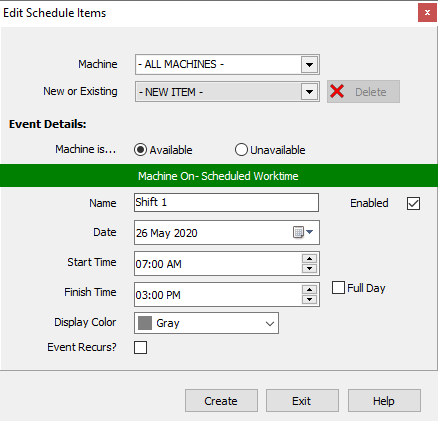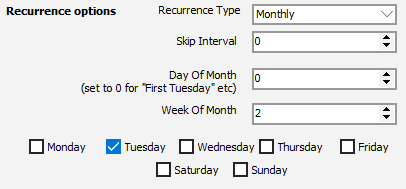In order for PrimeCut to accurately show when programs are expected to finish it must know how long a program will take (calculated from the computed run time, plus plate loading/unloading times and operator efficiency allowances) as well as the windows of time (schedule items) available to the machine when it is available for cutting. This section describes how to set these schedule items up. See also Scheduling Tutorials for examples of setting up a basic schedule, setting up lunch breaks, setting up an annual holiday and creating a machine breakdown event.
Scheduled Work and Non-Work Times
To make the most of the scheduled views and be able to get better estimates of completion times, scheduled work and non-work times need to be added to PrimeCut. To do this we need to have the 'Scheduling Work Times' permission enabled for the logged in user.
Initially we want to add our basic working schedule for the operating hours of the machines, we can refine this later by adding meal breaks, maintenance times etc. Work Times can be added for each shift, eg 7am-3pm Monday-Sat for "First Shift", 3pm-11pm Monday to Friday for "Second Shift". Break times, such as "lunch: daily 12pm-12.30pm" can then be applied over the top. Note that when a non-working time is added to the schedule, it implies that the machines will stop cutting during the break.
See the Scheduling Tutorials for how to set up your schedule.
If no schedule scheduled work times been created, a Default Schedule will be in use: basically weekdays, 9-5.
Recurring Events must have unique names (on a per-machine basis). That is if you have more than one machine, you can for example create a single recurring "Lunch" event for each, but only one for each machine. In Creating a Maintenance Outage we discuss this further.
Adding, editing or removing schedule events is done via the Edit Schedule Items window, which is access via the Edit Schedule button on the Planning screen.
Edit Schedule Items Window

Machine
Here we can select the machine we want to create/update schedule items for from the dropdown list
If set to - ALL MACHINES - then we are either going to create schedule events for all machines, or edit schedule items on all machines.
New or Existing
This will list all existing events. If a particular machine is selected above it will show only those events defined on that machine. If - ALL MACHINES - is active then it will show all events. Select the event you wish to edit.
If - ALL MACHINES - is active and you select and edit an item defined on a subset of those machines, then at the end you will be prompted for each machine its not defined on whether you want to add it.
The -NEW ITEM - selection is used to add a new schedule item.
Machine Is...
Available defines time when the machine is running (work-time). Unavailable defines time the machine is not expected to be work (non-work times), ie breaks, holidays, maintenance outages and breakdowns.
Note that breaks will take precedence over work-times when their time spans overlap. So a lunch-break will be a non-working time even though the workday is set as 9-5, or a holiday will override what would otherwise be a normal workday.
Name
The name of the schedule item. Should be unique per machine, ie there can only be one schedule item called "lunch" for each machine. When creating weekly workday schedules, the system may automatically append the weekday name to the schedule item names, see Creating a Schedule
Enabled
Schedule Items can be enabled or disabled. This makes it easy to add an extra shift and remove it when not needed.
Date
The date will be applied to a one off (no recurrence) option, otherwise it is the first possible date that the recurrence could be applied to.
Start Time and Finish Time
Start Time defines the start of the event, and Finish Time the end. If Finish time is less than Start Time, then it is assumed to refer to that time on the following day (wrap around). (For example 3rd shift may start at 11pm at finish at 7 am)
The Full Day option is a shortcut for setting the start and finish times to 00:00 and 23:59 respectively
Display Color
Affects how the item is rendered on the Planning page.
Event Recurs?
Uncheck for one-off events such as breakdowns. For recurring events, the dialog expands depending on the Recurrence Type:
Recurrence Options: Skip Interval
Usually 0, but use to skip a certain number of whatever the Recurrence Type intervals. eg if Recurrence Type is set to Daily, and Skip Interval is 9, then will occur on every 10th day
Recurrence Options: Finish Date
The recurrence will end after this date. Usually set to "the distant future", the year 3000.
Recurrence Options: Recurrence Count
Usually 0, but if non-zero the recurrence will end after this many repetitions. If non-zero this overrides Finish Date
Recurrence Type: Daily
The schedule item will occur every day. There are no further options.
Recurrence Type: Weekly
An option will be presented to allow you to select on which weekday the weekly event will occur.
A special case is when creating a weekly (or a week of month monthly or yearly) item, you will be presented with a series of checkboxes, one for each weekday. This allows you to quickly create the weekly event for multiple weekdays, for example creating a shift for Monday through Friday. In this case you are actually creating multiple schedule items at once, and each item will have the relevant weekday appended to its name, to keep the names unique and meaningful.

When editing a weekly event, you will be editing a specific weekday event, not all of them at once. ie you can create a shift "first shift" for 5 weekdays at once, but when editing them you will need to edit "first shift Monday", "first shift Tuesday" etc.
Recurrence Type: Monthly
You can either specify a specific Day of Month, or a Week Of Month in combination with a weekday or weekdays. Weekday specification works as described above and may involve creating multiple schedule items.
Either Day of Month, or Week Of Month should be non-zero, but NOT BOTH.
Negative values can be used to Day of Month: -1 means the last day of the month, -2 means the second to last day of the month etc.

Recurrence Type: Yearly
You can specify a specific date each year by specifying the Day of Month and Month of Year OR you can specify a weekday in the nth week of a given month by setting Month of Year and Week of Month.
Either Day of Month, or Week Of Month should be non-zero, but NOT BOTH.
Negative values can be used to Day of Month: -1 means the last day of the month, -2 means the second to last day of the month etc.
Weekday specification works as described above and may involve creating multiple schedule items.
